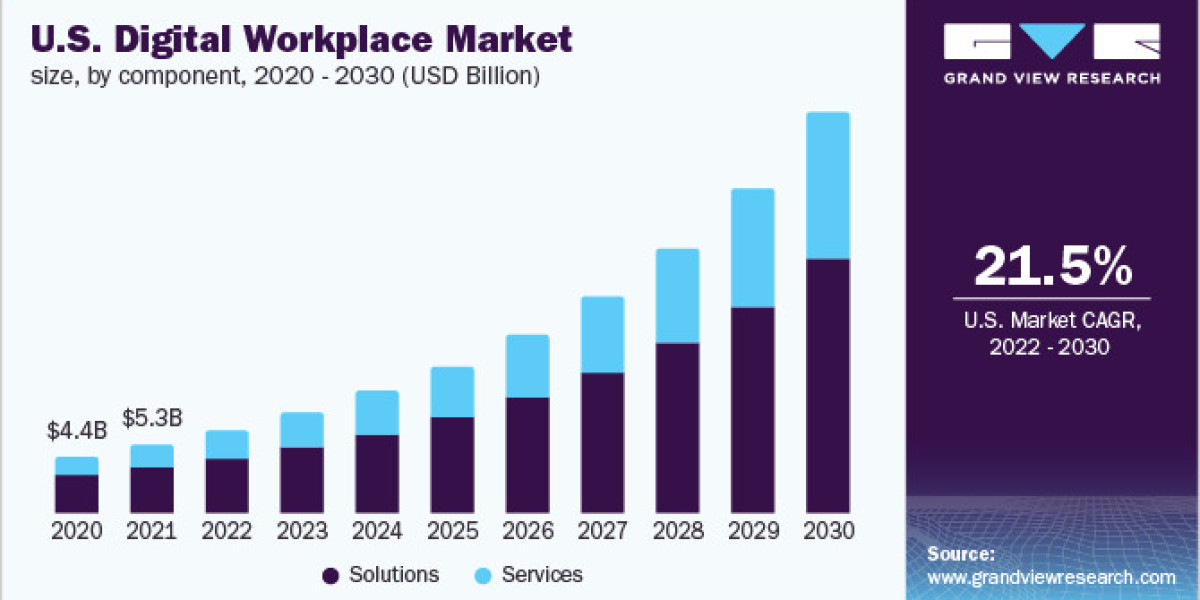The global digital workplace market was valued at USD 27.33 billion in 2021 and is projected to grow at a compound annual growth rate (CAGR) of 22.3% from 2022 to 2030. This growth is driven by increasing digitalization, the rising demand for desktop-as-a-service, and employees' desire for greater work-life balance flexibility. The COVID-19 pandemic accelerated the shift to remote work, prompting businesses to adopt digital workplace technologies to ensure continuity and productivity.
During the pandemic, the widespread use of video and web conferencing introduced new communication methods and fostered team collaboration in a virtual environment. As a result, many companies have made long-term investments in workplace transformation for hybrid work models, relying on cloud-based solutions for secure access and remote working capabilities.
Digital workplaces provide numerous benefits by leveraging smart technologies, enabling employees to work efficiently while maintaining business operations. For instance, in August 2021, HCL Technologies signed a contract with Munich Re, a German insurance company, to provide a next-generation digital workplace for 16,000 employees across 40 countries. HCL’s solution supports Munich Re’s global workforce in multiple languages, such as Spanish, German, and Mandarin, and enhances employee efficiency through personalized service desks, automation, and self-service options.
Gather more insights about the market drivers, restrains and growth of the Global Digital Workplace Market
The growing adoption of technologies like Bring Your Own Device (BYOD) and enterprise mobility is contributing to the market's expansion. These technologies offer greater flexibility and mobility, reducing the time and cost associated with managing business-owned devices and software licenses. This transformation of workplaces, supported by organizational restructuring, lowers operational costs for businesses.
Advanced technologies such as Artificial Intelligence (AI), the Internet of Things (IoT), and Virtual Reality (VR) are expected to drive the adoption of cloud-based, flexibility-enhancing solutions in workplaces. These advancements, along with automation, are creating new opportunities for companies to improve productivity and streamline operations.
For example, in May 2022, Wipro partnered with Scania, a transport solutions provider, to support Scania’s employees with automation and enhanced customer experience through Wipro’s Live Workspace. This partnership emphasizes sustainable transport solutions and a modern digital workplace experience, highlighting how cutting-edge technologies are shaping workforce management.
The demand for digital workplace transformation is being fueled by advancements in mobile technology, changing workforce demographics, and the rise of connected workplaces. Many organizations are increasingly adopting cloud services like Infrastructure as a Service (IaaS), Backend as a Service (BaaS), Platform as a Service (PaaS), and Software as a Service (SaaS) to improve business processes and increase productivity.
Cloud services allow organizations to provide employees with instant access to critical business data and enterprise applications on various devices, such as tablets, smartphones, and laptops, while maintaining security. These advantages are expected to drive further growth in the global digital workplace market over the forecast period.
Report Coverage & Deliverables
The report will provide insights into competitive benchmarking, historical data, forecasts, company revenue shares, regional opportunities, and trends shaping the industry.
Component Insights
In 2021, the solution segment held a 67.6% market share. This growth is attributed to the adoption of workplace solutions such as social collaboration tools, cloud storage, and content management systems, which improve resource usage and productivity. For instance, Trianz PULSE is a digital workplace solution designed for collaboration and communication among clients, vendors, and partners, centralizing remote workforce management and improving productivity.
The services segment, which includes consulting, training, support, and implementation services, is expected to grow at a CAGR of 23.5%. These services help organizations efficiently manage their digital workplaces, offering cost-effective support, reducing governance risks, and improving operational stability.
Enterprise Size Insights
In 2021, large enterprises accounted for 61.5% of the market revenue. Many large companies are adopting cloud-based technologies powered by AI and automation. For example, Tata Consultancy Services' (TCS) Cognix solution offers real-time dashboards and integrates augmented reality (AR), virtual reality (VR), and cognitive automation, helping large enterprises implement digital workplace solutions.
The Small and Medium Enterprises (SMEs) segment is projected to grow at a CAGR of 24.3%. Despite limited infrastructure, SMEs are rapidly adopting digital workplace services due to advantages such as increased productivity, lower operational costs, and improved customer experiences. Cloud services also offer SMEs scalability without the need for extensive manpower or hardware, further lowering their operating costs.
End-use Insights
The IT and telecom industry held 22.8% of the market share in 2021. Remote working trends, the adoption of Software as a Service (SaaS), and BYOD in countries like the U.S., India, and China have driven digital workplace adoption in the IT and telecom sectors. For instance, Infosys launched four digital platforms, including Launchpad, InfyMe, LEX, and Meridian, which facilitated remote work and hybrid models during the pandemic.
The healthcare and pharmaceuticals sector is expected to grow at a CAGR of 24.3%. Healthcare organizations are increasingly adopting digital workplace solutions to improve communication, collaboration, and information sharing across their operations. For example, Atos signed a contract with Bayer to implement global digital workplace solutions, enabling Bayer employees to use modern device management and automation technologies, further driving demand for digital workplaces in the healthcare industry.
This shift towards digital solutions is expected to continue driving the growth of the digital workplace market across industries during the forecast period.
Order a free sample PDF of the Digital Workplace Market Intelligence Study, published by Grand View Research.








